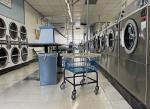OAKBROOK TERRACE, Ill. — A trio of self-service laundry operators described in some detail why the unattended store model best fits their business plan and lifestyle during a recent Coin Laundry Association (CLA) webinar.
In “The Unattended Laundromat: Making That Business Model Work in 2023,” Kevin Beggs (no relation to the author) of Massachusetts, Casey Wright of Minnesota and Brian Brunckhorst of Texas spoke about their operations and answered questions from the audience.
In Part 1, the trio introduced themselves and explained why they chose the unattended model. Let’s conclude:
ESTABLISHING SYSTEMS FOR SERVICE CONTINUITY
CLA CEO Brian Wallace asked about key operational systems the trio has in place to help them and anyone who assists them.
“All of our stores are (open) 6 a.m. to 10 p.m.,” says Wright, the operations manager for a group of nine Maytag Laundries in the Upper Midwest. “We have each so it automatically opens, automatically locks. We don’t have to depend on someone to do that with a key. … Also, all of our doors to cleaning rooms, changer rooms, even outside, all have a keypad. So anytime we need to have an HVAC (repair), or the city needs to come and put in a new water meter, whatever it is, we don’t have to be at the location.”
Cleaners have the flexibility to clean when they want during a given day. Between cleanings, someone will do a walk-through to pick up dryer sheets, empty the garbage, check the bathrooms, etc.
And for about the last year and a half, Wright and his workers have enjoyed the remote management benefits of a card payment system. Five of the nine locations have one, and more are being added over time.
“We have found things that work for us over the years, and we’ve tried to stress organization in our back room areas, for instance,” explains Beggs, who owns and operates nine unattended stores. “We like to have the same setup in all nine locations. You don’t want to have to remember nine different setups.”
Being unattended, you’ve got to make sure that your independent contractor, whoever is cleaning the store, is there often enough, according to Brunckhorst, whose seven Advantage Laundry locations are split between Texas and California.
“In some states, they can really be sticklers on who are the employees and contractors,” he warns. “So, you’ve got to make sure you follow the rules for your particular location. In most places, as long as they supply their own equipment to clean, they have their own business license to operate as a business within that area, and they’re not on any particular hard schedule as far as what time they come in and go, those are usually good enough to be able to pass that test.”
COMMUNICATIONS AND CUSTOMER SERVICE
When a problem arises in one of Beggs’ stores, a customer can dial a phone number to the company office.
“And if we don’t pick up at the office, it rings through to a 24-hour, seven-day-a-week live answering service. It’s not a machine, it’s a person, and then they write up the description of the problem and they’ll text that out to a group of us and whoever is designated as ‘on call’ for that day and time will return the call and talk to the customer and see what needs to be done.”
Brunckhorst says his stores offers added customer service through other means.
“We’ve put in video doorbells in each one of our stores, so if somebody has a problem, instead of actually having to pick up the phone, go through a menu, they can just hit the doorbell and get somebody right now. People like that. We’ve been getting a lot of very positive response from that.”
A PIECE OF ADVICE
As he wrapped up the conversation, Wallace asked each of the operators to offer one piece of advice to someone who might be thinking about an unattended operation.
“Upkeep’s a big one,” Wright says. “I like to go there and visit with customers. We’re not just there in and out, you know, collecting money. Go there at different times of the day, different days a week. Chat with customers. The card system has certainly made it easier for us. Being in small towns, we sometimes have initial pushback, resistance to change, but just stay on top of it. Keep updating the business. Keep updating the store.”
“If you’re unattended, you’re not under the same considerations and restrictions that a store operator who was fully attended or even partially attended would be,” Brunckhorst says. “So oftentimes what we're seeing is that for the fully attended stores, especially in these major markets, their pricing has to go up significantly as wages increase. But for the unattended stores, they can keep their pricing lower and so that becomes a disparity.”
“I think I would say, don’t worry about running a store unattended and not being able to compete. Provide a good service that people are going to value and use,” says Beggs.
The Coin Laundry Association frequently offers webinars that cover topics such as marketing, store operations and management, and new investor education. Visit www.coinlaundry.org/events/webinars to learn more.
Miss Part 1? Read it HERE
Have a question or comment? E-mail our editor Bruce Beggs at [email protected].


